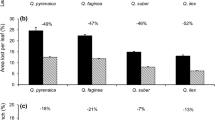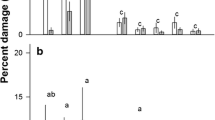Abstract
Variations in leaf traits (toughness, total nitrogen and total phenolic concentrations) and susceptibility to herbivory in Salix miyabeana were studied among individual trees within a population under field conditions. Leaf quality clearly decreased as season progressed, i.e. increases in leaf toughness and total phenolics and decrease in leaf nitrogen. Seasonal pattern and extent of herbivore attack were similar between years. Significant correlation between leaf traits and susceptibility to herbivore attack was detected, while effects of sex and plant size on leaf traits and herbivory were less clear. There was a negative correlation between total nitrogen and total phenolics, and a positive correlation between leaf toughness and total phenolics among trees. Trees with high quality leaves tended to suffer from frequent herbivore attack and leaf damage. Such a clear relationship between leaf traits and susceptibility to herbivory may be related with a life-history strategy of willows, which are rapid-growing pioneer species and generally respond to herbivorous damage not by induced resistance but by compensative growth.
Similar content being viewed by others
References
Auerbach M. and Alberts J.D. 1992. Occurrence and performance of the aspen blotch miner, Phyllonorycter salicifoliella, on three host-tree species. Oecologia 89: 1–9.
Baldwin I.T. and Schultz J.C. 1983. Rapid changes in tree leaf chemistry induced by damage; evidence for communication between plants. Science 221: 277–279.
Bryant J.P., Chapin F.S. and Klein D.R. 1983. Carbon/nutrient balance of boreal plants in relation to vertebrate herbivory. Oikos 40: 357–368.
Bryant J.P., Clausen T.P., Reichardt P.B., McCarthy M.C. and Werner R.A. 1987. Effect of nitrogen fertilization upon the secondary chemistry and nutritional value of quaking aspen (Populus tremuloides Michx.) leaves for the large aspen tortrix (Choristoneura conflictana (Walker)). Oecologia 73: 513–517.
Coley P.D., Bryant J.P. and Chapin F.S. III 1985. Resource availability and plant antiherbivore defense. Science 230: 895–899.
Craig T.P., Price P.W. and Itami J.K. 1986. Resource regulation by a stem-galling sawfly on the arroyo willow. Ecology 67: 419–425.
Elmqvist T., Ericson L., Danell K. and Salomonson A. 1987. Flowering, shoot production, and vole bark herbivory in a boreal willow. Ecology 68: 1623–1629.
Faeth S.H. 1986. Indirect interactions between temporally separated herbivores mediated by the host plant. Ecology 67: 479–494.
Feeny P.P. 1970. Seasonal changes in oak leaf tannins and nutrients as a cause of spring feeding by winter moth caterpillars. Ecology 51: 565–581.
Field C. and Mooney H.A. 1986. The photosynthesis: Nitrogen relationship in wild plants. In: Givnish T. (ed.), On the Economy of Plant Form and Function. Cambridge University Press, Cambridge, pp. 25–55.
Fox J.F. 1995. Shoot demographic responses to manipulation of reproductive effort by bud removal in a willow. Oikos 72: 283–287.
Fritz R.S., Roche B.M., Brunsfeld S.J. and Orians C.M. 1996. Interspecific and temporal variation in herbivore responses to hybrid willows. Oecologia 108: 121–129.
Haukioja E. 1990. Induction of defenses in trees. Annual Review of Entomology 36: 25–42.
Haukioja E. and Neuvonen S. 1985. Induced long-term resistance of birch foliage against defoliators: defensive or incidental? Ecology 66: 1303–1308.
Havill N.P. and Raffa K.F. 1999. Effects of elicitation treatment and genotypic variation on induced resistance in Populus: impacts on gypsy moth (Lepidoptera: Lymantriidae) development and feeding behavior. Oecologia 120: 295–303.
Hemming J.D.C. and Lindroth R.L. 1995. Intraspecific variation in aspen phytochemistry: effects on performance of gypsy moths and forest tent caterpillars. Oecologia 103: 79–88.
Herms D.A. and Mattson W.D. 1992. The dilemma of plants: to grow or defend. Quarterly Review of Biology 67: 283–335.
Ishihara M., Hayashi T. and Ohgushi T. 1999. Life cycle of the willow leaf beetle, Plagiodera versicolora (Coleopteta: Chrysomelidae) in Ishikari (Hokkaido, Japan). Entomological Science 2: 57–60.
Jonasson S., Bryant J.P., Chapin F.S. III and Andersson M. 1986. Plant phenols and nutrients in relation to variations in climate and rodent grazing. American Naturalist 128: 394–408.
Kagata H. and Ohgushi T. 2001. Resource partitioning among three willow leaf miners: consequence of host plant phenology. Entomological Science 4: 257–263.
Karban R. and Baldwin I.T. 1997. Induced Responses to Herbivory. University of Chicago Press, Chicago.
Karban R. and Myers J.H. 1989. Induced plant responses to herbivory. Annual Review of Ecology and Systematics 20: 331–348.
Kudo G. 1996. Herbivory pattern and induced responses to simulated herbivory in Quercus mongolica var. grosseserrata. Ecological Research 11: 283–289.
Larsson S., Wiren A., Lundgren L. and Ericsson T. 1986. Effects of light and nutrient stress on leaf phenolic chemistry in Salix dasyclados and susceptibility to Galerucella lineola (Coleoptera). Oikos 47: 205–210.
McNaughton S.J. 1983. Compensatory plant growth as a response to herbivory. Oikos 40: 329–336.
Mattson W.J. 1980. Herbivory in relation to plant nitrogen content. Annual Review of Ecology and Systematics 11: 119–161.
Mauffettee Y. and Oechel W.C. 1989. Seasonal variation in leaf chemistry of the coast live oak Quercus agrifolia and implications for the California oak moth Phryganidia californica. Oecologia 79: 439–445.
Neuvonen S., Haukioja E. and Molarius A. 1987. Delayed inducible resistance against a leaf-chewing insect in four deciduous tree species. Oecologia 74: 363–369.
Nichols-Orians C.M., Fritz R.S. and Clausen T.P. 1993. The genetic basis for variation in the concentration of phenolic glycosides in Salix sericea: clonal variation and sex-based differences. Biochemical Systematics and Ecology 21: 535–542.
Palo R.T. 1984. Distribution of birch (Betula spp.), willow (Salix spp.), and poplar (Populus spp.) secondary metabolites and their potential role as chemical defense against herbivores. Journal of Chemical Ecology 10: 499–520.
Price P.W. 1991. The plant vigor hypothesis and herbivore attack. Oikos 62: 244–251.
Price P.W. and Ohgushi T. 1995. Preference and performance linkage in a Phyllocolpa sawfly on the willow, Salix miyabeana, on Hokkaido. Research on Population Ecology 37: 23–28.
Price P.W., Roininen H. and Ohgushi T. 1999. Comparative plantherbivore interactions involving willows and three gall-inducing sawfly species in the genus Pontania (Hymenoptera: Tenthredinidae). Ecoscience 6: 41–50.
Rossiter M.C., Schultz J.C. and Baldwin I.T. 1988. Relationships among defoliation, red oak phenolics, and gypsy moth growth and reproduction. Ecology 69: 267–277.
Schultz J.C. 1988. Plant responses induced by herbivores. Trends in Ecology and Evolution 3: 45–49.
Schultz J.C., Nothnagle B.J. and Baldwin I.T. 1982. Individual and seasonal variation in leaf quality of two northern hardwood tree species. American Journal of Botany 69: 753–759.
Waddell K.J., Fox C.W., White K.D. and Mousseau T.A. 2001. Leaf abscission phenology of a scrub oak: consequences for growth and survivorship of a leaf mining beetle. Oecologia 127: 251–258.
Waterman G.P. and Mole S. 1994. Analysis of Phenolic Plant Metabolites. Blackwell Scientific Publications, Oxford.
Zvereva E.L., Kozlov M.V., Niemelä P. and Haukioja E. 1997. Delayed induced resistance and increase in leaf fluctuating asymmetry as responses of Salix borealis to insect herbivory. Oecologia 109: 368–373.
Author information
Authors and Affiliations
Rights and permissions
About this article
Cite this article
Kudo, G. Variations in leaf traits and susceptibility to insect herbivory within a Salix miyabeana population under field conditions. Plant Ecology 169, 61–69 (2003). https://doi.org/10.1023/A:1026209017627
Issue Date:
DOI: https://doi.org/10.1023/A:1026209017627




